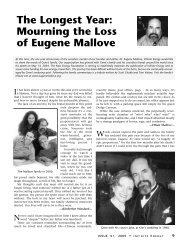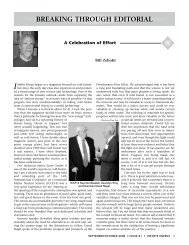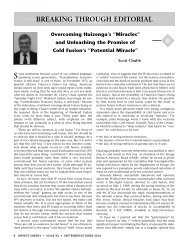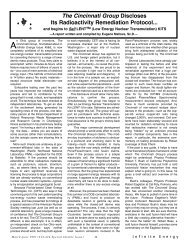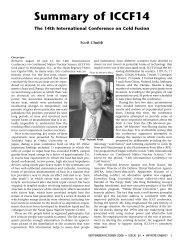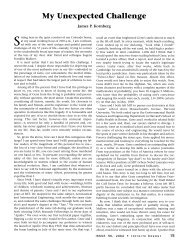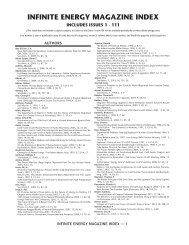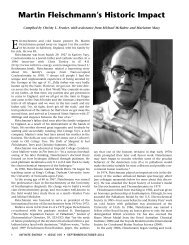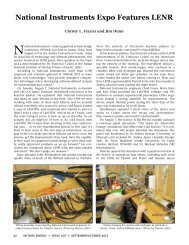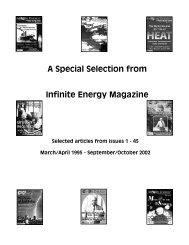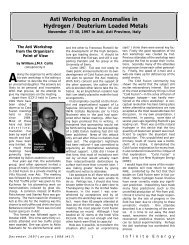MIT and Cold Fusion: A Special Report - Infinite Energy Magazine
MIT and Cold Fusion: A Special Report - Infinite Energy Magazine
MIT and Cold Fusion: A Special Report - Infinite Energy Magazine
You also want an ePaper? Increase the reach of your titles
YUMPU automatically turns print PDFs into web optimized ePapers that Google loves.
For its own good, <strong>and</strong> to restore some civility to a contentious<br />
field, <strong>MIT</strong> should look into ( 1 ) how its scientists<br />
came to perform <strong>and</strong> publish such a poor experiment, (2)<br />
why they either misdescribed their results, making them<br />
seem more meaningful than they were or used a subtle correcting<br />
procedure without describing exactly what it was,<br />
(3) how it came about that data from calorimeters with a<br />
claimed sensitivity of 40 mw converged, between drafts,<br />
after completion of the experiments, to within perhaps<br />
5 mw of the result that hot fusion people would prefer to see.<br />
It might have been chance, but it might not.<br />
—Dr. Charles McCutchen<br />
Like me, Philip Morrison took the paper’s results at face<br />
value. He calculated for himself the mean excess power shown<br />
in the heavy <strong>and</strong> light water data in the draft of July 10, 1989. A<br />
little average excess power came from the light water cell <strong>and</strong><br />
more from the heavy water cell, which suggests that the height<br />
of the curves was not intended to be meaningless. Had the procedure<br />
simply subtracted the best-fit ramp from each curve,<br />
both of these averages would have been close to zero.<br />
The published paper shows negligible average excess power<br />
from either cell. The change between draft <strong>and</strong> published version<br />
is what would have happened had the ramps been adjusted<br />
to yield the result that hot fusion experimenters preferred.<br />
I underst<strong>and</strong> that the experimenters have been unwilling to<br />
explain their procedure when asked, <strong>and</strong> have refused to give<br />
others their data.<br />
Another piece of apparent a posteriori adjustment in the paper<br />
concerns the calibrating procedure. The draft said that dry<br />
nitrogen was bubbled through the electrolyte to stir it. Nitrogen<br />
from from a gas cylinder or from evaporating liquid is dry. But<br />
dry nitrogen would cool the cell by evaporation. The nitrogen<br />
should have been bubbled through water at cell temperature on<br />
its way to the cell. In the published paper, “dry” was missing.<br />
For its own good, <strong>and</strong> to restore some civility to a contentious<br />
field, <strong>MIT</strong> should look into ( 1 ) how its scientists came to perform<br />
<strong>and</strong> publish such a poor experiment, (2) why they either<br />
misdescrlbed their results, making them seem more meaningful<br />
than they were or used a subtle correcting procedure without<br />
describing exactly what it was, (3) how lt came about that data<br />
from calorimeters with a claimed sensitivity of 40 mw converged,<br />
between drafts, after completion of the experiments, to<br />
within perhaps 5 mw of the result that hot fusion people would<br />
prefer to see. It might have been chance, but it might not.<br />
I think all parties would agree that if the experimenters thought<br />
their method of baseline correction would not conceal constant or<br />
slowly varying excess power they should have explained it in<br />
detail. If, on the other h<strong>and</strong>, both the height <strong>and</strong> the slope of their<br />
records were meaningless, they should have said so. I believe this<br />
information, whichever it is, should now be published.<br />
Sincerely yours, Charles W. McCutchen<br />
cc: Dr. Eugene F. Mallove, Professor Philip Morrison<br />
H<strong>and</strong>-written note attached in copy to Eugene Mallove:<br />
Dear Gene,<br />
Here it is. I hope <strong>MIT</strong> does something other than stonewall. I<br />
think my request is reasonable. If the height <strong>and</strong> slope of the curves<br />
mean nothing, the experimenters should say so in<br />
a corrigendum. If the slope subtraction scheme<br />
somehow left meaningful slope <strong>and</strong> height, they<br />
should explain why this is so in a corrigendum.<br />
You have my permission to copy <strong>and</strong> distribute<br />
my letter if you think it would help to get<br />
the matter straightened out.<br />
Sincerely yours, Charles<br />
McCutchen<br />
Exhibit Z-5<br />
Prof. Morrison’s <strong>Report</strong> to President Charles<br />
Vest<br />
March 20, 1992<br />
Yet another letter from Prof. Morrison to President<br />
Vest, concerning the <strong>MIT</strong> PFC experiment<br />
controversy <strong>and</strong> the new analysis by Dr. Mitchell<br />
Swartz. Morrison’s conclusion that “though the<br />
procedure was described in only a few lines, a<br />
technically-prepared reader who uses the entire paper can work<br />
out the missing details to a good degree,” is patently not true. The<br />
<strong>MIT</strong> PFC paper on the Phase-II calorimetry is fraudulently deceptive.—EFM<br />
Department of Physics,<br />
<strong>MIT</strong>, Cambridge, MA 02139<br />
From: Philip Morrison, Institute Professor<br />
(emeritus)<br />
To: Charles Vest, President<br />
Response to Your Letter of 10 March 1992<br />
I. Question <strong>and</strong> Answer<br />
Your letter put to me a specific, rather narrow question, whose background<br />
is a recent painstaking study of a particular research paper (<strong>and</strong><br />
two draft manuscripts) from <strong>MIT</strong>. The critical study, largely directed at<br />
a few specific graphs <strong>and</strong> their captions, was carried out by Dr. Mitchell<br />
Swartz, Weston, MA; its final date is 27 Jan 1992. The research paper<br />
itself, by Albagli et al., with 16 co-authors, came from the <strong>MIT</strong> Plasma<br />
<strong>Fusion</strong> Center, <strong>and</strong> was published in the Journal of <strong>Fusion</strong> <strong>Energy</strong>, vol. 9,<br />
no. 2, p. 133, 1990.<br />
You wrote me: “The question I wish you to examine is: Is the data<br />
reduction method that was used. . . [to produce certain curves in the<br />
published paper referenced above] satisfactorily described? “<br />
My reply is this: though the procedure was described in only a few<br />
lines, a technically-prepared reader who uses the entire paper can work<br />
out the missing details to a good degree.<br />
That reader would certainly be reassured by having for comparison<br />
the data for the heater power of the light water comparison cell. Those<br />
data were not in the published paper, though they were made available<br />
by Dr. Luckhardt in a letter of August 13,1991, sent by Director Parker<br />
of the Plasma <strong>Fusion</strong> Center to Dr. Mallove (Mallove Attachment #12).<br />
But I do not think I should stop abruptly. As a physicist, I want to outline<br />
the logic of the procedure, address the results, <strong>and</strong> even add a little<br />
new matter. Dr. Swartz’s study seems to me to warrant a fuller explanation<br />
for your records (to augment my first response) <strong>and</strong> for possible<br />
transmission to others you may wish to inform.<br />
II. Source Documents Used<br />
The letter <strong>and</strong> manuscript from Dr. Swartz are the direct basis for my<br />
comments. But it was valuable as well to use the August 18,1991 letter<br />
of Dr. Eugene Mallove to you, with its many attachments, <strong>and</strong> my letter<br />
of last October (harmlessly misdated in Dr. Swartz’s study). Both of<br />
these were available also to Dr. Swartz, <strong>and</strong> cited in his Appendix.<br />
I was also supplied through your office with a new <strong>and</strong> fuller account<br />
of the data treatment procedures, an account prepared by Dr. Stan Luckhardt<br />
of the Plasma <strong>Fusion</strong> Center, who carried out the original calculation<br />
(Luckhardt MEMO, 3/10/92). Dr. Luckhardt <strong>and</strong> I have spoken by<br />
phone as well.<br />
I return all those documents for your files. I have destapled <strong>and</strong> restapled<br />
some of the papers, <strong>and</strong> made a few tick marks.<br />
53 <strong>Infinite</strong> <strong>Energy</strong> • ISSUE 24, 1999 • <strong>MIT</strong> <strong>Special</strong> <strong>Report</strong>



